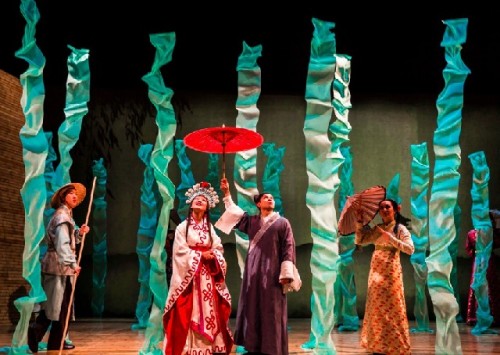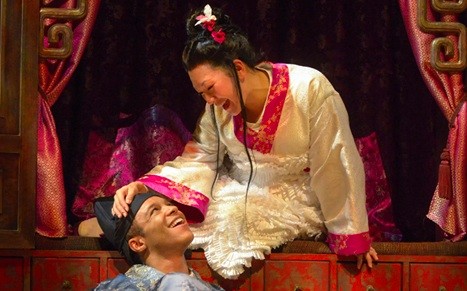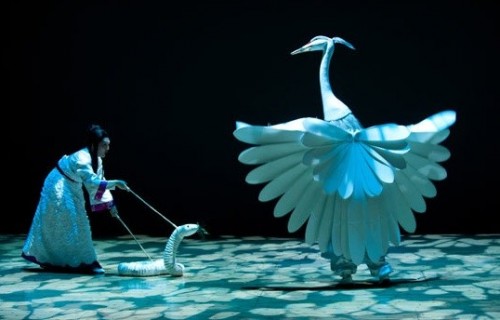Mary Zimmerman's The White Snake
Goodman Theater in Chicago Mounts the Chinese Tale
By: Susan Hall - May 19, 2014
Mary Zimmerman’s The White Snake is now playing at the Goodman Theatre in Chicago. It has been produced at the Oregon Shakespeare Festival and also at the Berkeley Repertory Theater, so this is not a premier struggling to find its way.
To recap the story, a white snake wishes to experience the pleasures of human life and works to transform herself to attract a man’s love. She succeeds in this, but is sent back to live under a rock by an evil monk. She is or is not rescued by the son born of her human marriage.
Lit lanterns are marched around the stage and up from the orchestra level at the finale. Is everything okay now?
Zimmerman’s signature work is the adaptation of classic myths and stories for a modern audience. Often choices are made based on her “I love it” reaction. In Metamorphosis, billed as ‘based on Ovid’ she included stories Ovid never wrote because she loved them.
Zimmerman’s ‘in love’ stance may suggest the immediate difficulty with the staging of this classic Chinese myth. Chinese word characters appear to be projected on the curtain before the play’s opening.
To my ear, the music is based on Chinese forms, although as the play progresses some of the songs sound clearly Disneyesque.
Movements and gestures mix a clear representation of what is going on, for instance in the polling of a boat in which the actors move like the boat in smooth, slow, forward steps.
Another successful gesture sequence is portrayed by hands with extreme elongation of fingers and nails, attached to a figure standing behind Xu Xian, and twisting over his head, a visual representation of his tortured mind.
The longevity of this story is depicted in part by the narrators’ periodic punctuations: the story forks here, either this happened or this happened. Such complexity does not help the drama as it is staged.
What to do about the transition from snake to human?
Zimmerman’s choice: rod puppet snakes shimmying on the floor and manipulated beautifully by the two lead actresses, Amy Kim Wascheke and Tanya Thai McBride. In a recent La Mama production of Lysistrata life size puppets were manipulated by actors in black.
These puppets, created by Theodora Skiptares, Jane Catherine Shaw and Cecilia Schiller were both life-sized mannequins and miniatures, living parasite like on the bodies of actors.
Some incorporation of the puppetry with the human actors would have helped The White Snake immeasurably. The puppet snakes slithering on the floor are just too distant, even though their postgenitors make moving wooden rods look like fun. White and green snake tails that occasionally appear seem to mop the stage floor.
The leading male interest, Xu Xian was played credibly by Jon Norman Schneider, who was moving in his attraction and his devotion. Matt de Caro was compellingly evil and manipulative as the monk Fa Hai.
By bringing the language of the principals forward into the present and presenting particularly the White Snake’s sidekick, Greenie, as a hip teen, Zimmerman appears to be trying to make the story live now. Yet is jarring to have the set, costumes and background Chinese à la Turandot, and to have these characters whose language is very present dressed in ancient garb.
The staging might have worked better with the four principals in contemporary Chinese wardrobe to indicate the present day relevance of the story. Keeping it against a background of ancient China would suggest the longevity of the story. A timeline on stage. Not in the mishmash now before us.
The story’s message is hammered home in the last few minutes: we do not have to die alone. Other messages are occasionally delivered during the proceedings: you can marry whoever you want to – a gay person, a transvestite or a demon snake. These ideas are plopped into the proceedings and are uncomfortably pronounced.
Whether or not you like Disney, they never err this way in their presentations of myth. They are always on point and encompass you. You can’t slip out through inconsistent cracks.
Zimmerman’s work is often lovely to look at. Her incomprehensible Armida at the Metropolitan Opera was nonetheless gorgeous. Yet in this production, the visuals are skimpy. If the purpose was to suggest timelessness it does not work, because the costumes and backdrop are so clearly dated. Whatever virtues the music and setting have are ruined by the language and the time confusion in the characters.
The tale of the White Snake has been told world over. It doesn’t play at the Goodman. Too confusing. Cheap jokes about forks in the road being like a snake’s forked tongue. A story that can be either love story or tragedy is neither.





